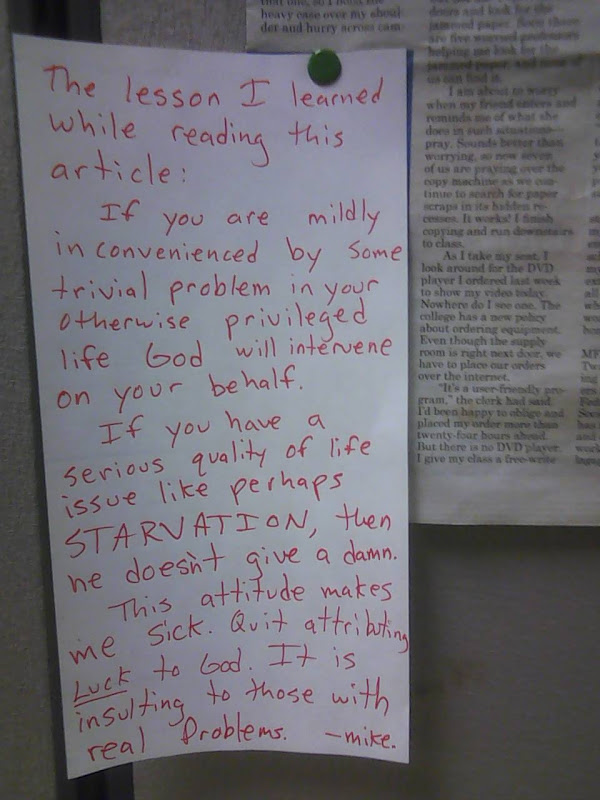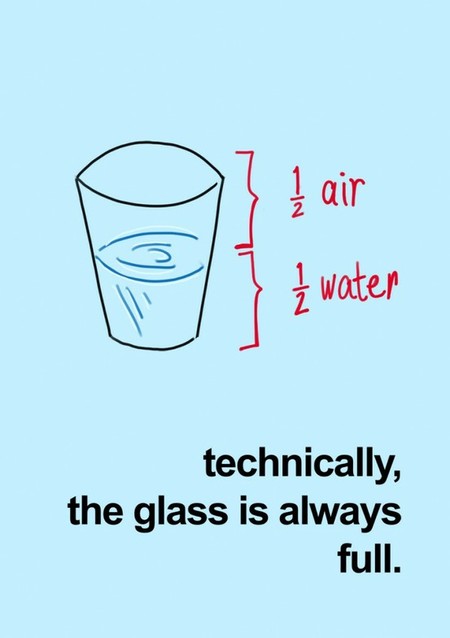Monthly Archives: November 2010
10 of the Best iPhone Apps
Written by David Pogue

From left, SoundHound, FakeCalls and Dragon Dictation.
I noticed that the No. 1 most e-mailed New York Times article for all of last week was Bob Tedeschi’s list of great iPhone apps. It’s still on the most-e-mailed list. Wow—hot topic, eh? O.K., fine—two can play that game. Here are my top 10 iPhone apps.
1. Dragon Dictation (free)
Speak to type. In general, excellent accuracy. After the transcription appears, one tap slaps the text into an outgoing e-mail message, text message, Twitter or Facebook update. Or just copies it to the clipboard. Not as good as dictating directly into any box where you can type, as on Android phones. But much faster than typing with your finger. My review is here.
2. Ocarina ($1)
People complain about their kids becoming addicted to their gadgets. But on long rides, I’m delighted that my son and daughter spent hours practicing this bona fide wind instrument. Blow into the microphone, learn the fingerings of the four “holes” on the glass screen…beautiful music. It was one of the first apps I reviewed.
3. Google Mobile (free)
Speak to search Google’s maps. Now with Google Goggles built in: Point the phone’s camera at a book, DVD, wine bottle, logo, painting, landmark or bit of text, and the hyper-intelligent app recognizes it and displays information about it from the Web.
Bonus suggestion: Google Voice. Hot off the presses! This app finally surfaced on the app store after a year and a half in limbo, as Apple mysteriously refused to approve it. But it’s here, it’s sweet, it offers free text messages, cheap international calls, free transcripts of your voicemails, and a raft of other useful features. I reviewed it just this week after its release.
4. LED Light (free)
The LED “flash” on the iPhone 4 is incredibly powerful; you could practically light up a runway with it. It’s fantastic for reading menus and show programs in dim light, for inspecting plumbing and car parts in narrow spaces, and for removing splinters. Unfortunately, turning it on involves opening the Camera app, switching to video and turning on the video light. Right? Not anymore. Just open this app to activate the LED instantly—bright and easy.
5. FlightTrack Pro ($10)
Incredible. Shows every detail of every flight: gate, time delayed, airline phone number, where the flight is on the map, and more. Knows more—and knows it sooner—than the actual airlines do. Better yet: the Pro version auto-syncs with Tripit.com. You book a flight online; you forward the receipt to [email protected]; and Tripit puts the flight details into FlightTrack Pro wirelessly and automatically. You never do any data entry at all. I reviewed it last year.
6. FakeCalls
When you tap this icon on your Home screen (it’s disguised and labeled only FC), in about ten seconds, your phone rings. It’s a fake call from—anyone you’ve selected in advance. (I have mine set to Barack Obama, but that’s just me.)
The simulation of the iPhone’s traditional incoming-call screen is perfect—ringtone, contact info, Mute and Hold buttons, the works. Ideal for extricating yourself from difficult situations, like meetings or bad dates.
7. Line2 (free)
Gives your iPhone a second phone line with its own number—one that makes or receives calls over WiFi when you’re in a hot spot (no AT&T minutes!), or over AT&T when you’re not. Unlimited texting, unlimited calling, $10 a month. I’ve reviewed it several times, most recently in September.
8. Twitter (free)
Most free Twitter apps are a bit on the baffling side. This one is the official app from Twitter, Inc., and it’s simple and clean.
9. SoundHound (free)
Beats Shazam at its own game. Hold this app up to a song that’s playing on the radio, or even hum or sing the song, and the app miraculously identifies the song and offers you lyrics. It’s faster than Shazam too.
10. Bump (free)
If you and another iPhone owner both have this app, you just bump your phones together to exchange business cards. Sadly, it’s gotten a lot more complex as it’s matured, to the extent that a buddy and I could barely figure out how to store the received “card.” But although there are many similar apps, this is the one most people are most likely to have already, making bumping extra convenient.
What else is on my iPhone? Red Laser. Glee. Kayak. FlightBoard. OnTime. The New York Times, of course. Skype. Kindle reader, B&N eReader. Dictionary. Facebook. WeDoodle. TEDPlayer. Mint.com. FingerFoos. Scrabble. Remote (for Keynote). SpawnHD. FourSquare. Pandora. MobileMe apps (FindiPhone, iDisk, Gallery). Yelp. Flickr. And about 65,000 little games and fun apps deposited by my kids on car trips.
Happy apping!
Bonus:This Video Will Blow Your Mind (Probably)
Slow down. You move too fast.


The 5 Most Profitable Drugs They Never Cure You
Written by Jason Parham
 In this week’s cover story, writer Keegan Hamilton investigates the controversy surrounding ibogaine, the experimental hallucinogen drug that has helped kick meth and heroin addictions.
In this week’s cover story, writer Keegan Hamilton investigates the controversy surrounding ibogaine, the experimental hallucinogen drug that has helped kick meth and heroin addictions.
Ibogaine is illegal, even though its power to cure addicts has been proven. Hamilton’s story describes the many reasons the medical establishment and the government are wary of Ibogaine, despite its benefits, but one of them really stood out:
Because Ibogaine is an outright cure, drug companies want nothing to do with it.
Martin Kuehne, a chemist at the University of Vermont, is quoted in the story, saying, “Pharmaceutical companies don’t like cures. Really, they don’t — that’s the sad thing. They like treatment. Something for cholesterol or high blood pressure that you take for years and years, every day. That’s where the profit is.”
When we read that, a light went on. The worst thing for a drug company is a pill you take that completely cures you of your ailment with one dose, right? Where’s the money in that?
So, with that in mind, we thought we’d test Kuehne’s theory, and look at the five most profitable drugs in the United States.
Guess what they all have one in common? They never cure you.
1) Lipitor (2009 gross revenue: $7.5 billion): Designed to lower cholesterol, Lipitor uses statins to decrease LDL cholesterol and triglyceride levels and increase HDL cholesterol levels. Studies indicate that high cholesterol increases one’s chance for heart disease, the leading health problem in the U.S.
2) Nexium (2009 gross revenue: $6.3 billion): This well-marketed drug decreases the amount of acid produced in the stomach, but it’s not an instant cure for heartburn.
3) Plavix (2009 gross revenue: $5.6 billion): Nobody likes a nasty blood clot, and this drug prevents that from happening, particularly after a stroke or a heart attack. The downside: Plavix increases your chances of small-injury bleeds and, if drinking alcohol, heightens your risk of stomach and intestinal bleeds.
4) Advair Diskus (2009 gross revenue: $4.7 billion): For asthma sufferers, a twice-daily inhaler to reduce the swelling in your respiratory system. Helps keep attacks from being more severe.
5) Seroquel (2009 Gross: $4.2 billion): Rounding out our top 5 is Seroquel, an anti-psychotic drug that treats schizophrenia, severe depression, and bipolar disorder by altering chemical activity in the brain.
Bonus: TIL the continents can be rearranged to form a chicken

Dogs Don’t Understand Basic Concepts Like Moving
Written by Allie
Packing all of your belongings into a U-Haul and then transporting them across several states is nearly as stressful and futile as trying to run away from lava in swim fins.

I know this because my boyfriend Duncan and I moved from Montana to Oregon last month. But as harrowing as the move was for us, it was nothing compared to the confusion and insecurity our two dogs had to endure.
Our first dog is – to put it delicately – simple-minded. Our other dog is a neurotic German shepherd mix with agonizingly low self-esteem who has taken on the role of “helper dog” for our simple dog. Neither dog is well-equipped with coping mechanisms of any kind.
When we started packing, the helper dog knew immediately that something was going on. I could tell that she knew because she becomes extremely melodramatic when faced with even a trivial amount of uncertainty. She started following me everywhere, pausing every so often to flop to the ground in an exaggeratedly morose fashion – because maybe that would make me realize how selfish I was being by continuing to pack despite her obvious emotional discomfort.



When the soul-penetrating pathos she was beaming at me failed to prevent me from continuing to put things in boxes, the helper dog became increasingly alarmed. Over the ensuing few days, she slowly descended into psychological chaos. The simple dog remained unfazed.



Unfortunately for the helper dog, it took us nearly a week to get everything packed up. By the time we were ready to begin the first part of our two-day journey to Oregon, she seemed almost entirely convinced that she was going to die at any moment. She spent the entire car ride drooling and shaking uncontrollably.

But the simple dog seemed to enjoy the trip.

Even though she threw up seven times.





She actually seemed to like throwing up. To the simple dog, throwing up was like some magical power that she never knew she possessed – the ability to create infinite food. I was less excited about the discovery because it turned my dog into a horrible, vomit-making perpetual motion machine. Whenever I heard her retch in the backseat, I had to pull over as quickly as possible to prevent her from reloading her stomach and starting the whole cycle over again.
But as far as the simple dog was concerned, it was the best, most exciting day of her life.

It wasn’t until we stopped for the night in Umatilla that the simple dog became aware that there was any reason for her to feel anxious. But at around two o’clock in the morning, the simple dog finally realized that something was different and maybe she should be alarmed.

This particular dog is not anywhere near the gifted spectrum when it comes to solving problems. In fact, she has only one discernible method of problem solving and it isn’t even really a method.
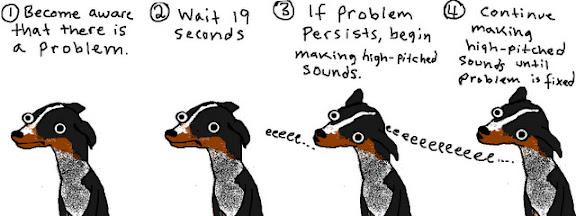
But making high-pitched noises won’t solve your problem if your problem is a complete inability to cope with change. Unfortunately for everyone involved, the simple dog did not understand this concept and she went right ahead and made an interminable amount of noise that was just invasive enough to make sleeping impossible.
After an hour of failed attempts at comforting the simple dog, her constant, high-pitched emergency-distress-signal became a huge problem.
I tried to communicate my displeasure to the simple dog, but communicating with the simple dog usually goes like this:






She was going to make that sound forever if she felt it was necessary. We tried everything from spooning her to locking her in the bathroom, but none of it was even the slightest bit effective.






The simple dog made the noise all through the night and was still going strong the next morning. When we were loading the dogs into the car, the constant, high-pitched sound emanating from the simple dog finally broke the helper dog. The helper dog wailed in anguish, which alarmed the simple dog. In her surprise, the simple dog let out a yelp, which further upset the helper dog. And so it continued in a wretched positive-feedback loop of completely unnecessary noise.

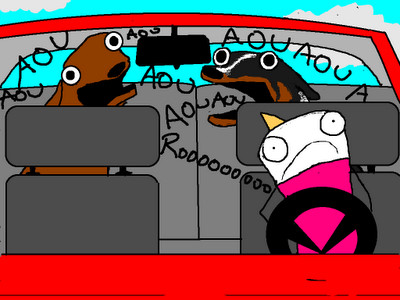
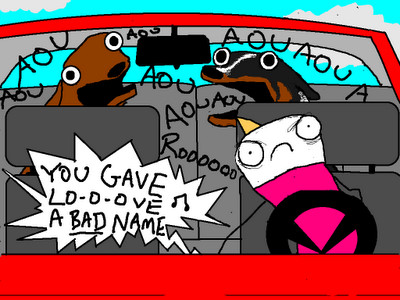
When we finally arrived at our new house, the dogs had calmed down considerably. Unfortunately, it had snowed the night before and there was still snow on our front lawn, and that was enough to catapult both dogs back into hysteria.
The simple dog had either never experienced snow or she’d forgotten that she knew what it was, because when we let her out of the car, she walked around normally for about seven seconds, then she noticed the snow and her feeble little mind short-circuited.

At first, the simple dog was excited about the snow. She started prancing around the yard like she was the star of a one-dog parade – her recent personal crisis overshadowed by a haze of enthusiasm.

The prancing turned to leaping and the leaping turned to running chaotically in stupid little circles. Then she just stopped and stared at the ground. There was a visible shift in her demeanor as she realized that she didn’t understand snow and it was everywhere and she should probably be scared of it. She started making the noise again.

Not surprisingly, the helper dog interpreted the snow as a sign of her imminent demise. But she was so exhausted from worrying about all of the other signs of her demise that she just gave up and accepted her death. She peered up at us, half-buried in the snow. Her eyes were filled with pain and helplessness, as if she thought we had summoned the snow for the sole purpose of making her sad.

We decided that it would probably be best to bring the dogs inside.
As a condition for allowing us to have dogs in our rental house, our landlady made us promise that we wouldn’t let the dogs scratch the wood floors. We didn’t anticipate it being a problem because it hadn’t been in the past, but as soon as our dogs set foot in the house, they morphed into perfectly engineered floor-destroying machines. They started sprinting as fast as they could for absolutely no reason – skittering around in circles to avoid running into the walls.

We finally corralled them in the bedroom and shut the door to give ourselves a little time to regroup and come up with a plan. Until we could get some rugs or convince the dogs that it was unnecessary to sprint around chaotically for no reason, we would need to find some way to prevent them from scratching the floors. What we ended up doing was going to the pet store and buying two sets of sled dog booties. It was the only way.
It is easy to imagine that a dog who has recently experienced a dramatic upheaval of its formerly safe and predictable life might not react well to suddenly having strange objects attached to all four of its feet. This was most definitely the case with the booties.
The helper dog panicked and started trying to rip the booties off with her teeth.


I scolded her and she reacted as if I’d ruined her entire life.

But at least her immobilizing self-pity kept her from chewing the booties off.
The simple dog just stood there and looked at me in a way that would suggest she didn’t realize her legs still worked.

They had to wear the booties for two days. Those two days were filled with the most concentrated display of overemotional suffering I have ever witnessed. The simple dog spent most of her time standing in the middle of the room looking bewildered and hurt and the helper dog refused to walk, instead opting to flop her way around the house like a dying fish.

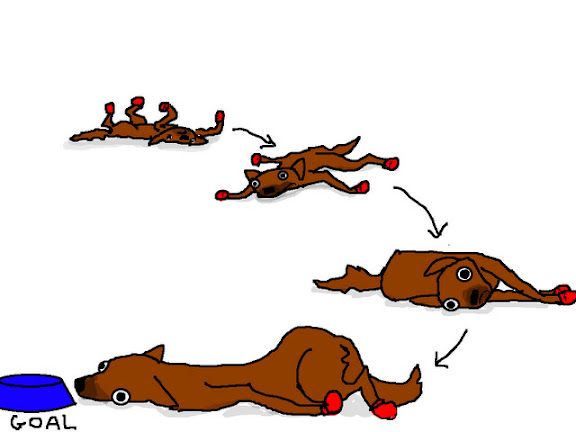
The entire ordeal was punctuated by the simple dog’s high-pitched confusion alarm.
We were beginning to think that our dogs were permanently broken. Nothing we did helped at all to convince the dogs that we had only changed houses and our new house was not, in fact, some sort of death-camp and we weren’t actually planning on killing them to fulfill an organ harvest ritual. Despite our best efforts, they continued to drift around in a sea of confusion and terror, pausing only to look pitiful.
But while we were unpacking, we found a squeaky toy that was given to us as a gift shortly before we moved. We offered the toy to the dogs. This may have been a mistake.
Upon discovering that the toy squeaked when it was compressed forcefully, the simple dog immediately forgot that she’d ever experienced doubt or anxiety ever in her life. She pounced on the toy with way more force than necessary, over and over and over. The logic behind her sudden change in outlook was unclear.

But at least she was happy again.

He works in mysterious ways I guess
17 Excellent TV Screenshots
Written by bannedinhollywood

If it weren’t for the invention of TiVo and the subsequent rise of what should now be commonplace in every home, the DVR box, we would have to do things like watch commercials, run to the restroom to take a leak, and most importantly we would miss 90-percent of the following 17 excellent TV screenshots.
God bless the DVR.
Bonus:Optimism
14 Reasons Why You Need To Start A Startup
Written by Jason Baptiste
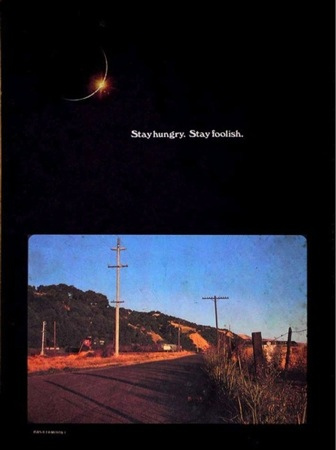 This post has been ruminating with me for a while. It’s not a sudden “a-ha” moment that made it form, but a collective group of “a-has!” over the past few months. Consider this the uplifting post to counter last week’s “The 11 Harsh Realities Of Entrepreneurship”. Just because it’s a harsh reality, doesn’t mean you shouldn’t be an entrepreneur. The best time to start a startup is not tomorrow, not next week, and certainly not next year. The time is right now, at this very second. Here’s why:
This post has been ruminating with me for a while. It’s not a sudden “a-ha” moment that made it form, but a collective group of “a-has!” over the past few months. Consider this the uplifting post to counter last week’s “The 11 Harsh Realities Of Entrepreneurship”. Just because it’s a harsh reality, doesn’t mean you shouldn’t be an entrepreneur. The best time to start a startup is not tomorrow, not next week, and certainly not next year. The time is right now, at this very second. Here’s why:
1. You Will Have The Time Of Your Life
I put this first, because it’s the reason that will motivate you the most to start a startup. Doing this may be hell at times, but boy is it fun. It’s an adventure that you will remember for the rest of your life whether things go very well or things go poorly. They used to say that everyone should try to be a rockstar at least once in their lifetime. I’m going to add to that and say that in-between being a rockstar and something else, you should be an entrepreneur at some point just for the adventure. Writing this article makes me realize how much I truly love doing this – the uncertainty, the victory, the failure, the connections with customers, the press,etc. I couldn’t see myself doing anything else and if this is truly for you, you will eventually feel the same.
2. You Have The Power To Create Something From Nothing
Few professions have the power to create something from absolutely nothing whatsoever. Right now, you may have some crazy idea in your head to bring into the world. It exists on some napkins, photoshop files, etc. right now, but eventually it will become reality. There’s a good chance it’s something that will have an impact on a large number of people… millions of people around the world. That wasn’t something many could achieve, even 20 years ago. Now, it’s possible for anyone, anywhere. I rarely use absolutes, since I know what that means, but I truly believe the ability to start a startup can happen anywhere. It’s certainly more difficult in poor countries, but it’s still possible. Look at Kiva.org or posts like this on HN.
3. A World Of Knowledge Is Available
It used to be a very old boys club or dark art, when it came to entrepreneurship. It used to cost a ton of money to go to seminars and buy books full of snake oil. It still exists, but people are starting to learn better. The experiences of previously successful and/or failed entrepreneurs are everywhere. They are on this very site, they are posted hourly on hacker news, daily on Mixergy, and found through smart people on Twitter. The blueprint to go from zero to paying customers and all the knowledge in between to guide you is out there in the open… for free.
4. Cloud Computing And Web Apps Make It Cheap To Start
Ten years ago it used to cost a lot to get started in terms of software+hardware. If you planned on doing anything with scale, you needed what equated to a front loaded CapEX of 500k to buy the equipment YOU might need. Software for internal collaboration costed a lot, with very few choices available. Software for actual development was even more costly. Now we have mature open source frameworks/databases and cloud apps. Startup Weekends occur every weekend and are possible due to this advancement in software. I almost feel weird writing this because we’ve taken what’s in front of us for granted. Amazon EC2 scales well, but now it’s even free to test out initially for your project. Of course, your time isn’t free, but even that is reduced with libraries+frameworks like JQuery and Ruby On Rails. Odds are, if there is something you need, it’s out there and available for free. If it’s not, there is probably someone to talk to.
5. Location Isn’t Important At First
I still think certain geographical areas have their place once you reach certain scale along with what type of business you are building (lifestyle vs. venture backed). In today’s day and age, you can START your company anywhere in the world and get great visibility. I’m seeing more and more companies come from random spots in the US along with international waters. Take a look at Balsamiq, WooThemes, or where Backupify originted (Kentucky!). The ability to access customers is available globally and you can run a distributed team due to the previous point listed above (cloud apps). Face to face time is always a good thing, but it’s a whole lot easier to book a flight once every 8 weeks than to pick up and move to 94306 right out the gate. If location is a worry for you, then don’t worry anymore. Don’t be pressured to race to the valley right away. If another geography makes sense, you will know in due time. You can start getting the most important thing right now, where you are… NOT funding… CUSTOMERS.
6. You Can Get Press And Attention Overnight
Getting press used to require an overpriced PR firm to the tune of $10,000 a month when getting started. Now a great product with a well crafted story can blow up overnight and get the attention of mainstream media+the tech elite. Take a look at Chat Roulette. Though it’s not a shining example of a great business, it is a shining example of the attention that a company can get press overnight.
7. There Are More Customer Acquisition Channels Than Ever Before
Getting customers used to be a really hard thing. It used to take a lot of money to make money. At scale, it certainly takes a lot of money to optimize an efficient sales machine with CAC, LTV,etc., but to get started, you can use a variety of customer acquisition channels. Public relations, inbound marketing, search engine marketing, in person events, platform distribution, direct sales, affiliate programs, and a ton more currently exist. They can be strategically used with little capital. Why does this matter? It’s like having more lives in a video game. Many of the channels won’t work out, that’s just life. If there are more channels, then you have more opportunities for success.
8. It’s Possible To Make A Living From A Startup Fairly Fast
It used to be that businesses would take years and years of losses to get to the point of making enough money to pay for you to live. If you wanted to do one, you had to raise a significant amount of capital up front, usually in the form of credit cards + savings from your job. In today’s day and age, it’s just completely different. You can start charging for software, increase your customers with a certain level of profitable scale, and get to the point that your barebones living is paid for. We also live in a subscription economy, where revenues are recurring. With things like churn aside, customers are now that gift that keep on giving. It won’t bring you riches right away, but it’s fairly reasonable for a team to create software and make a living within a 6 months period. Building a venture backed company is usually different, but lifestyle ISVs can sometimes morph into one. 37 Signals chose to stay independent, but if they wanted to do the raise money + grow fast show, they could have quite a while ago.
9. The Capital To Grow Is Widely Available If You Need It
The capital raising world is going through an interesting transitionary period. Since entrepreneurs need less to get to certain milestones, a new class of investors have sprung up, leading smaller and smaller deals. It used to be do a larger angel round or Series A, after having a lot of traction to get started. Deals took a while and the terms varied a lot. Now the spectrum varies heavily. You can get funding from YCombinator or TechStars at a ~18k level for just the idea+being a smart team, a $250-500k seed round in multiple flavors, a traditional larger angel round of $1,000,000, or the full Series A. I actually haven’t seen the full Series A as the first round of financing in a while, now that I come to think of it. A word of caution: many people think they should raise money, just because they see it in the press. That’s the wrong way to go about. You should raise money for a specific reason. In the case of the small ~18k YC round, it usually entails getting the first working version of the product out to get initial customer validation. Anything above that should be strategic to hit certain customer + traction milestones. If you don’t know what those are, don’t raise money yet.
10. You Will Make Friends And Connections That Will Last A Lifetime
This is one of my top three reasons on the entire list on why to start a startup. The friends you will make, just stay with you forever. There is a certain bond that connects you. It takes an entrepreneur to understand what another entrepreneur goes through. We tend to all stick together and the bond that is formed is very very deep. I’ve been at this for about 5 years, since I was 19 going on 20. Many of the friends I have today were there with me when I first got started. It’s also a very very small world when it comes to the tech entrepreneurship ecosystem. Everyone is at most 3 degrees of separation away, but it often seems to be something closer to 2 degrees. A lot of people will give up along the way and find out entrepreneurship isn’t for them. If you stick around long enough, the pool shrinks, and the people who began their career around the same time as you have advanced far along too. For example, when I first met Noah, he had just started at Facebook. Now he’s done great things through Facebook, Mint, started Get Gambit, and is killing it with AppSumo. I can point out the same for a dozen other people. It’s great to see your friends that have stuck it out start to succeed.
11. The Amount Of New Platforms And Technologies Is Staggering
Most of the platforms that exist today weren’t around 36-48 months ago. Mobile was owned by the carriers and MySpace was still fairly dominant. The tools now available to build new companies upon is truly remarkable. It’s certainly very difficult to have a lack of problems to solve in unique ways. The more new technologies and platforms that become available, the more companies that can be built over time. Without Facebook we wouldn’t have Zynga and without the iPhone we wouldn’t have companies like Square. Without the advancements in SaaS/Cloud computing, we wouldn’t have companies like HubSpot or ZenDesk.
12. Finding Out Whether You Are Right Takes Far Less Risk
It used to take many many months and lots of capital to find out whether you were on to something. That just isn’t true anymore. You can find out if you’re right in some time period that is under 60 days. If you’re right keep peeling away more layers. If you’re wrong, pivot a bit, and move on to the next thing. It’s not a zero sum game. You shouldn’t fear failure, but embrace the process that comes with it. Test your ideas via Amazon Mechanical Turk, talk to customers, buy some basic keyword tests on Amazon, and find out whether you are right. You can do this with close to no capital and get over one of the biggest humps a startup faces in its first 6 months: Knowing whether you are building something people want.
13. A Traditional “Job” Isn’t Much More Secure In The Long Run
Oh sure, you’re a great engineer or marketer. You could get a high paying, possibly even six figure job right now. Add in some benefits and things sound great. Here’s the truth: no job is safe in this world. Wall Street practically collapsed overnight and larger companies do “layoff roulette”. At least doing a startup is some function of having survival that is within your control. When you’re fired, that is usually it. When you go through the equivalent of “being fired” in the startup world, you can fight back. You can persevere and stay determined.
14. The Worst That Can Happen, Isn’t Really That Bad
It seems a lot worse when you think about it now, but it really isn’t that bad. If your startup fails you will hurt afterwards for a decent while physically, emotionally, and financially. People have been in far worse positions and triumphed. If things fail you either a) try something new startup wise b) join another company whose mission you believe in c) take a new direction in life. Failure at a startup, DOES NOT mean failure at life. I’m not trying to play down the horrible reality that comes with failure. I’m just trying to say this: “You will bounce back and you will live to fight another day”.
Bottom line: If your gut tells you to go for it and there’s something you really believe in, then go for it. We need more startups, as they are the change agents that can save the world. Why do you think now is the best time ever to start a startup? What made you take the entrepreneurial plunge?
I love meeting fellow entrepreneurs. Follow me on Twitter: http://www.twitter.com/jasonlbaptiste, Friend me on Facebook: http://www.facebook.com/jasonlbaptiste, Email Me: [email protected], or even call me: 772.801.1058
Like this? Help spread the word.
Bonus: Sunday Afternoon on the Island of Le Grande Jatte

16 of the Dumbest Things Americans Believe & the Right-Wing Lies Behind Them
Written by Sarah Seltzer
Americans are often misinformed, occasionally downright dumb, and easily misled by juicy-sounding rumors. But while the right wing is taking full advantage of this reality, the Left worries that calling out lies is “rude.”
Remember when Congressman Joe Wilson stood up during Obama’s State of the Union address and shouted “You lie”? He was chastised soundly by the pundit class. But mostly he drew heat for being impolite, and was compared to Kanye West and other famous interrupters.
Revisiting Wilson’s foolish tirade underscores the state of our upside-down political world. Wilson shouted “you lie” in the face of truth, but President Obama is hesitant to speak up when he’s being slandered with bald, glaring untruths. The dark irony will continue as the Republicans take over the House this winter and the rumors and insinuations from extremist right-wing pundits keep circulating. It feels like no one with a loud enough megaphone has the courage to call a spade a spade, or more accurately a lie a lie.
We’ve gone far beyond Stephen Colbert’s “truthiness” into a more “truth-be-damned” environment; what Rick Perlstein described in the Daily Beast as a “mendocracy. As in, rule by liars.”
Here are some examples of recent ways we have made inroads in ignorance:
- Polling data during and after last week’s midterm elections suggested that many Americans genuinely believe President Obama has raised their taxes — even though the reality is that our president actually lowered them for most of us. This means that people trust pundits like Rush Limbaugh, a major force behind spreading that lie, over the numbers on their own tax returns.
- Another recent phenomenon? Half of new Congressmen don’t believe in the reality of global warming. It’s not that they don’t just disagree on the source or the severity of the problem. They flat out don’t think the world is getting warmer–despite the evidence outside their windows.
- The new Congress will probably try to restore millions of dollars of funding for scientifically inaccurate, largely disastrous abstinence-only curriculum in schools, many of which have been shown to spread lies like “condoms don’t work” and “abortion causes cancer.”
- News outlets picked up a wildly inflated and completely outlandish claim from an Indian blog that Obama’s trip abroad cost $200 million a day–and listeners have swallowed it. (In this case, the White House flat-out denied it.)
The scary thing is, these kinds of rumors have a way of taking root in the popular consciousness. Just as the election season began heating up earlier this year, Newsweek published a list of “Dumb Things Americans Believe.” While some of them are garden-variety lunacy, a surprising number are lies that were fed to Americans by our leaders on the far-Right. This demonstrates that media-fed lies can easily become ingrained in the collective memory if they’re not countered quickly and surely. Newsweek’s list included the following 12 statistics taken from recent and semi-recent polls and surveys. The first half are directly related to right-wing rumormongering.
- Nearly one-fifth of Americans think Obama is a Muslim. Thanks, Fox news, for acting like this was a matter of opinion, not fact.
- 25 percent of Americans don’t believe in Darwin’s theory of evolution while less than 40 percent do. Consider the fact that several of our newly elected officials, specifically newly elected Kansas Governor Sam Brownback, share that belief.
- Earlier this year, nearly 40 percent of Americans still believed the Sarah Palin-supported lie about “death panels” being included in health care reform.
- As of just a few years ago, about half of Americans still suspected a connection between Saddam Hussein and the attacks of September 11, a lie that was reinforced by none other than Dick Cheney.
- While a hefty amount of this demonstrable cluelessness gets better as the respondents get younger, all is not well in the below-30 demographic. A majority of “young Americans” cannot identify Iraq or Afghanistan–the places their peers are fighting and dying–on a map.
- Two out of five Americans, despite the whole separation of church and state being a foundation of our democracy thing, think teachers should be able to lead prayer in classrooms. So it seems those right-wingers clamoring to tear down the wall between church and state aren’t the only ones who don’t know their constitutional principles.
- Many Americans still believe in witchcraft, ESP and other supernatural phenomena. Does that explain why Christine O’Donnell was so quick to deny her “dabbling”?
- Speaking of antiquated religious beliefs, about a decade ago, 20 percent of Americans still believed that the sun revolves around the earth. That’s just sad, considering that even the Vatican has let Galileo off the hook for being right.
- Only about half of Americans realize that Judaism is the oldest of the three monotheistic religions. Other examples of wild misunderstanding about religion and the separation of church and state can be found in this fall’s Pew survey on Americans’ religious knowledge.
- This one made a huge splash when it appeared. In 2006 more Americans were able to name two of the “seven dwarves” than two of the Supreme Court justices. And that was before Kagan and Sotomayor showed up. To be fair, Happy and Sleepy are easy to remember.
- More Americans can identify the Three Stooges than the three branches of government–you know, the ones who are jockeying over our welfare.
So what to do in a political and cultural landscape in which well-told lies have more validity than fact-based truth? Perlstein explained how this environment gets created by explaining what happened on Election Day this year:
“…by a two-to-one margin likely voters thought their taxes had gone up, when, for almost all of them, they had actually gone down. Republican politicians, and conservative commentators, told them Barack Obama was a tax-mad lunatic. They lied. The mainstream media did not do their job and correct them. The White House was too polite—”civil,” just like Obama promised—to say much. So people believed the lie.”
We’ve entered a bizzarro world in which calling out lies is considered rude, says Perlstein, so liars are allowed to sit tight and dominate the discourse. This gels with Bill Maher’s critique of the Rally for Sanity, that calling for “balance for balance’s sake” ignores two important aspects of news reporting: facts and evidence.
Blaming Americans for being ignorant unwashed masses–or taking potshots at an education system that doesn’t teach critical thinking– would be the easy answer to this conundrum.
But the reality is that if messaging has such a big effect on Americans, then messaging matters. Folks on our end have to counter the lies with well-told, unabashed unironic, truth-telling. And we have to demand that our media, and our politicians, call out the other side. As Perlstein notes, “When one side breaks the social contract, and the other side makes a virtue of never calling them out on it, the liar always wins. When it becomes ‘uncivil’ to call out liars, lying becomes free.”
Even worse, once lies begin to spread, they become more than rumors–they become permanent beliefs.
Sarah Seltzer is an associate editor at Alternet, an RH Reality Check staff writer and a freelance journalist based in New York City. Her work can be found at www.sarahmseltzer.com.
Bonus: LEEROY!

20 Misconceptions Taught at School
Wrttten by eloren

Photo from Wikimedia Commons
Seems many of the things we take for granted as common knowledge just aren’t true, and that many of these so-called facts were taught us at school. Here are 20 misconceptions about the world.
1. Water is blue because it reflects the sky
Water looks blue because pure water is a blue chemical. The blue color is caused by the molecular structure as well as selective absorption and scattering of the light spectrum. Impurities and other elements such as algae or plankton can create variations in the color. Water appears clear in a cup or in a shallow pond because it’s only slightly blue and there isn’t much water volume.

Photo by Sharon Pruitt
2. We need to drink 8 glasses of water per day
Experts agree we need eight cups of water per day. But most people assume that ‘cup’ – a unit of measurement for liquids – means ‘glass’ – which can be anywhere up to half a litre. The actual amount we need is about two litres of water a day.
But you don’t need to drink just water, since it’s present in many drinks (such as juices and tea), as well as food like fruits and vegetables.
The most correct statement? Drink when you are thirsty.
3. The Greenhouse Effect is the cause of Global Warming
The greenhouse effect often gets a bad rap because of its association with global warming, but the truth is we couldn’t live without it.
The greenhouse effect is the process by which the infrared radiation from the Sun, reflected back from the surface of the Earth, is absorbed by greenhouse gases such as water, CO2 or ozone. These gases trap the heat and regulate the climate, and are essential for our survival.
Anthropogenic Global Warming is caused by human activity, creating more greenhouse gases than necessary. Ultimately, more gases means more infrared absorption, which gradually increases Earth’s temperature beyond ‘normal.’

Photo by Swamibu
4. Diamonds are made of compressed coal
The idea of diamonds being formed from the metamorphosis of coal is still a widely taught concept, but a wrong one. The misconception is because diamonds and coal are both made of carbon; however, coal comes from plants and most diamonds date from well before any living plants on Earth.
The carbon that makes diamonds comes from the melting of rocks in the Earth’s upper mantle. If conditions such as the chemistry, pressure and temperature are right, carbon atoms can be formed into diamond crystals.
5. We only use 10% of our brain
A better statement is that we normally use only about 10% of our brain at a time. Different activities trigger different parts of the brain. For example, solving a mathematical problem uses different brainpower than watching a movie or cooking dinner. Over the course of a day, most people use all parts of their brain.

Photo by Bala
6. The North Star is the brightest star
If you try to find your way in the wild at night by following the brightest star, you’ll probably end up getting lost. Polaris, also known as the North Star, isn’t actually all that bright and is hardly seen from your backyard.
The brightest star in the sky (apart from the Sun) is Sirius, located in the Canis Major constellation.
7. There is no gravity in space
Watching astronauts take giant leaps for humanity on the Moon or drift in space around the ISS, it’s easy to assume there is no gravity in space. Actually, any object with a mass exerts a gravitational pull, and space is full of objects. The strength of this pull depends on both mass and distance.
Astronauts in orbit are still subject to the Earth’s gravity, but are weightless because they are in a constant state of free-fall as they orbit the Earth. Walking on the Moon, astronauts are no longer in free-fall and so are subject to the Moon’s gravity – about one sixth the strength of Earth.

Photo from Wikipedia
8. The Great Wall of China is seen from space
Just shy of 9,000 km long, the Great Wall of China is the longest manmade object on Earth, and it is often said it can be seen from space, even from as far away as the Moon. But both NASA and even China’s first astronaut have said this is not possible.
The Great Wall is narrow and irregular, measuring about 10m wide on average, and can be hard to distinguish from the surrounding environment. Seeing it from the Moon would be equivalent to seeing a single hair from 2,688m away.
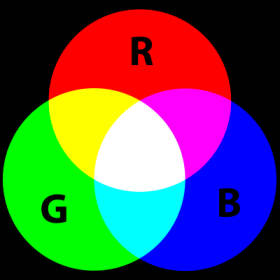
Photo from Wikipedia
9. Seasons result from the elliptical nature of Earth’s orbit
If this were true, winter would be hotter than summer, since Earth is closer to the Sun in early January than in early July. And besides, the difference in distance is relatively small.
Seasons are caused by the Earth’s tilt, meaning different parts of the planet lean towards (summer) or away from (winter) the Sun at different times of year. The tilt determines the Sun’s height in the sky and the amount of sunshine a given location receives. That’s why it is winter in Australia when it’s summer in Europe.
10. Red, Yellow and Blue are the primary colors
The primary colors are actually Red, Green and Blue (RGB). More specifically, the primary colors of light are RGB and the primary colors of pigment are Cyan, Magenta and Yellow (CMY).
Unlike RGB and CMY, red, yellow and blue can’t reproduce every color in the visible spectrum – RYB has a significant bias towards browner colors!
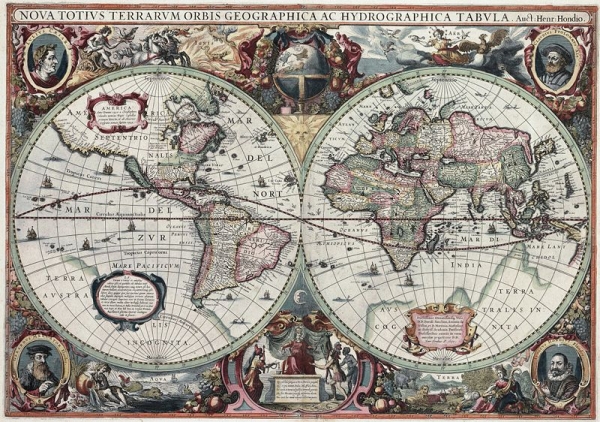
Photo from Wikimedia Commons
11. Columbus discovered America
At 2 am on the 12th of October 1492, land was sighted aboard the Pinta and the discovery of America was attributed to Christopher Columbus.
But Native Americans had settled the Americas before Columbus (obviously). There is also cartographic evidence that Portuguese explorers visited the Americas and mapped the area in 1424. Additionally, Norse explorer Leif Erikson set foot on the shores of Newfoundland in Canada, long before 1492. Remains of Viking-type settlements were found in 1963, and dated to about half a century before Columbus.
12. Edison invented the light bulb
Actually, historians list up to 22 inventors of the incandescent lamp before Thomas Edison, starting with Sir Humphry Davy in the early 19th Century.
But in 1878, Edison challenged himself and his workers to produce a commercially viable and longer lasting light bulb, based on the work of inventors before him. In October 1879, by creating an extremely high vacuum inside a bulb and using a carbon filament, he filed a US patent for the first practical high-resistance lamp capable of burning for hundreds of hours.
So while he didn’t actually invent the lightbulb, he did produce the first version that was practical for everyday use.

Photo from Wikipedia
13. Gutenberg invented the printing press
Thanks to Johannes Gutenberg, Western civilization has enjoyed books for centuries, and they are only now being replaced (slowly) by E-readers.
But Gutenberg was not the first to invent the printing press or movable type. Print technology originated in China in 593 AD, and the Chinese were printing from movable type in 1040 AD.
Gutenberg was, however, the first European to use movable type in 1439, and probably invented it independently of the Chinese. But unlike in Eastern culture, prints had a larger influence in the West, making people believe it was invented in Europe.
14. Thanksgiving is not all peaceful and humble
Thanksgiving Day in America is a time to offer thanks, and gather with family around holiday meals of turkey, stuffing, cranberry sauce and pumpkin pie. A chance to reflect on the old tradition of colonial settlers and Native Americans coming together to give thanks for a successful season’s harvest.
Because of this celebration, people often think relations between colonialists and native people were fair and friendly. But relationships between Europeans and Native Americans never had a happy ending, and the role of European disease, cultural conflict, and disputes over land and resources defined their long-term interaction. The relative peace between the Pilgrims and the Wampanoag began to deteriorate as early as the 1660s, resulting in war by 1675.
The first Thanksgiving story is but one small piece of the long and often tragic history of relations between native people and European colonists.

Photo by CharmainZoe
15. Cleopatra was Egyptian
Cleopatra is widely known for being a beautiful, charismatic queen of Egypt and the wife of Julius Caesar. But she wasn’t Egyptian.
Born in 69 BC, the last Pharaoh of ancient Egypt was actually of Macedonian Greek heritage, daughter of Ptolemy XII. She gave herself the title of Pharaoh, and was one of the few rulers to learn the Egyptian language. (Most others preferred to use Greek.)
16. Marie Antoinette said “Let them eat cake”
There is no historical evidence she said this when asked about the starving French peasantry who were suffering from a bread shortage. The phrase originally appeared in one of Rousseau’s “Confessions”, when Marie Antoinette was only 10 years old. Today, most scholars believe Rousseau coined the phrase himself, or that it can be credited to Maria-Theresa, the wife of Louis XIV.
Nevertheless, because Marie Antoinette was an unpopular queen with a reputation for being hard-hearted and disconnected from her subjects, the starving French of 1789 willingly attributed the words to her. She was executed by guillotine in 1793 after the French Revolution.

Photo from Wikipedia
17. Napoleon was short
In reality, Napoleon was of average height for a Frenchman at that time, around 5?7?. The confusion came from a difference in measurements: both the English and the French used inches (pouces in French), but the pouce was a little longer than the British inch. After Napoleon’s death, the autopsy conducted by French and British doctors assigned a height of 5’2” in British measurements rather than French; a mistake which British propaganda was happy to propagate.
Furthermore, Napoleon was often surrounded by tall bodyguards, as was the requirement for the Imperial Guard. His soldiers also called him “Le Petit Caporal” (The Little Corporal), which was more a term of affection than a description of his height.
18. Water in the sink turns in a different way depending on the hemisphere
This statement is based on the Coriolis Effect, an apparent force caused by the Earth’s rotation that makes objects appear as though they are moving on a curved path. This effect has a major influence on large, long-lived phenomena such as hurricanes or ocean currents, but is insignificant in the case of draining water, which lasts only a few minutes and can hardly be considered large.
The only factors which affect the direction of the water as it empties down a drain are the shape of the container it’s draining from, and the way the water was introduced into the container.

Photo from Wikimedia Commons
19. Plants only respire at night
Another common misconception is that plants photosynthesize during the day and respire only at night.
Photosynthesis is a process that converts carbon dioxide (CO2) into sugar using energy from sunlight, and releases oxygen as a waste product. Cellular respiration is a process by which cells harvest the energy stored in food. Like most living beings, plants must respire in order to grow and produce energy. Cellular respiration occurs continuously in plants, not just at night.
20. Bats are blind
Despite tiny eyes and a nocturnal lifestyle, none of the 1,100 known bat species are blind, and while most rely on echolocation to hunt, some use primarily their vision. Scientists have determined bats can distinguish between different patterns and shapes, and possibly between colors too.
COMMUNITY CONNECTION
What other common misconceptions are there floating around? Share some examples in the comments below.
Bonus: I want this dog -)



